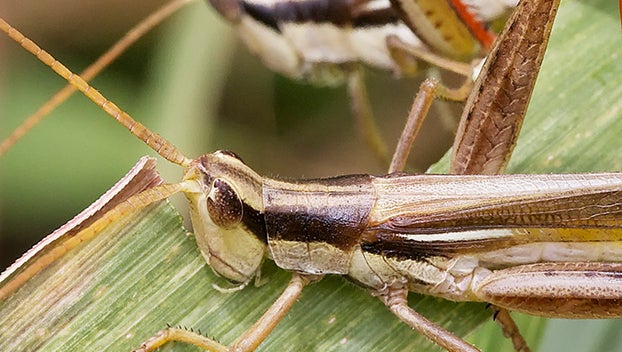CERTIFIED TEXAS EXPERT GARDNER — Keep watchful eye on detrimental garden pests
Published 12:02 am Wednesday, March 27, 2024

- Grasshoppers are known to have voracious appetites and can decimate plants if left unchecked. (extensionentomology.tamu.edu)
|
Getting your Trinity Audio player ready...
|
Today’s topic is directly associated with last weeks’ discussion regarding the management of insect populations and is the beginning of a three part series, where we review a few of the most common garden pests that affect Southeast Texas gardens.
Many gardeners will manage … or at least try to manage insect populations. Some gardeners are more successful than others.
This is often proportional to our ‘personal’ comfort level! Insects are a part vital of life and we need to understand that without them we will not exist.
Many of you (me included) have purchased plants, such as tropical, perennial, annual, ferns, succulent, vegetable transplants, hanging baskets or sown seeds that have germinated. Valuable resources: time, energy, and money have been committed.
As gardeners, we are expecting a “return on our investment.” Gardening is a process that requires obligation.
Purchasing plants is the simple beginning of a detailed process. Simply adding plants to a flower garden, vegetable bed or hanging basket is the precursor for gardening events, as is applying water.
Frequent and determined effort is essential if your expectations are to be attained. Here’s my point, there are gardeners who may not provide the detailed focus needed to ensure plants not only survive, but thrive producing an abundance of blooms, speedy growth or exceptional harvest.
Gardening is a ‘process’ with multiple steps which when deployed effectively will meet or exceed a gardener’s expectations.
Let me state that whenever possible this gardener’s initial line of defense against detrimental insects is always by selecting organic methods. The least invasive method is always selected first, since insecticides always have environmental consequences and can dramatically affect habitats and pollinator populations, even if used correctly.
It is imperative to know your foe through research, then follow the manufacturers’ application guidelines for a “targeted” insect audience.
So, let’s chat about insects, which negatively affect most SETX gardens:
Aphids – are born with a ‘one track mind’ (replicating) and can reproduce immediately from birth, which means aphid populations can grow exponentially, quickly overpowering host plants.
There are several ways to remove aphids from plants: manually by hand-picking them off plants which is tedious and gross (typically, this is an unrealistic approach unless there are a few aphids), using a garden hose nozzle to blast them away (which can damage the plant), utilizing organic Neem oil, companion planting (onions, garlic, chives, dill, fennel, nasturtium, and catnip) or use of beneficial insects such as Lady Beetles ‘lady bugs’ (which never hang around after the job is finished).
The “onion” family plants (allium) and others have a ‘special’ odor aphids dislike, and most humans would agree. Planting any member of the allium family can reduce aphid populations.
If planting “allium” family members isn’t an option, you can create a mixture which can be sprayed and for me has always proven to be highly effective for the eradication of aphids on vegetables and flowering plants. Place a small onion (quartered), two garlic cloves, 1 tbsp. of baby shampoo and 2 cups of water into a blender, blend for a minute, then allow the mixture to stand overnight.
Strain through a fine sieve (a coffee filter will work). Pour the strained mixture into a handheld spray bottle and spray affected plants.
Cucumber Beetles – are yellow and black insects, which are a nuisance to most of us who enjoy growing cucurbit varieties. The cucurbit family includes numerous varieties, such as cucumbers, pumpkins, gourds, zucchini, summer & winter squash, watermelon, and cantaloupe.
Cucumber beetles are the primary carrier of cucumber mosaic virus, and often carriers of numerous bacterial and viral diseases. Unfortunately for SETX gardeners, the beetle’s life cycle is approximately eight weeks, so theoretically three generations are possible within our ‘normal’ growing season.
It is my opinion that affected plants are to be removed quickly and should never be composted, since diseased plants may attract more beetles. There are a few ways to reduce cucumber beetles’ population, but complete control may be elusive for some gardeners. Cover young plants with row covers or screens.
Sow seeds later in the season (beetles will migrate to other gardens), mulch the soil surface with straw, hay, plastic, or fabric which can deter the beetles from laying eggs in the soil near the plants but note this will not eliminate them entirely.
Another helpful tip is to mix of ½ cup wood ashes (not from the BBQ grill or briquettes) with ½ cup hydrated lime in two gallons of warm water. The mixture, when sprayed on to the upper and lower leaves will provide a seasonal, limited measure of control.
Grasshoppers – are notorious for their voracious appetites but are easily controlled by applying a mixture made from (you probably guessed it) garlic. The “odiferousness” of garlic discourages them and other insects. An effective recipe blends two to three bulbs of garlic into 10 cups of water, then heating the “garlic-water” to a low boil, allowing the mixture to cool overnight.
Strain the mixture through a fine sieve or paper coffee filter. Fill a spray bottle with one part of the cooled garlic solution, then add three-parts water. Spray on plant leaves, top and bottom. Another successful approach is attracting birds to garden areas with feeders and baths, while this approach does not have immediate resolution, it is another sustainable, environmentally sound method.
Next week’s list includes hornworms, leaf-footed “stink bugs” and “miners” and mealy “bugs.”
Send Certified Texas Expert Gardener John Green your questions and, please, continue sending comments to jongreene57@gmail.com.





